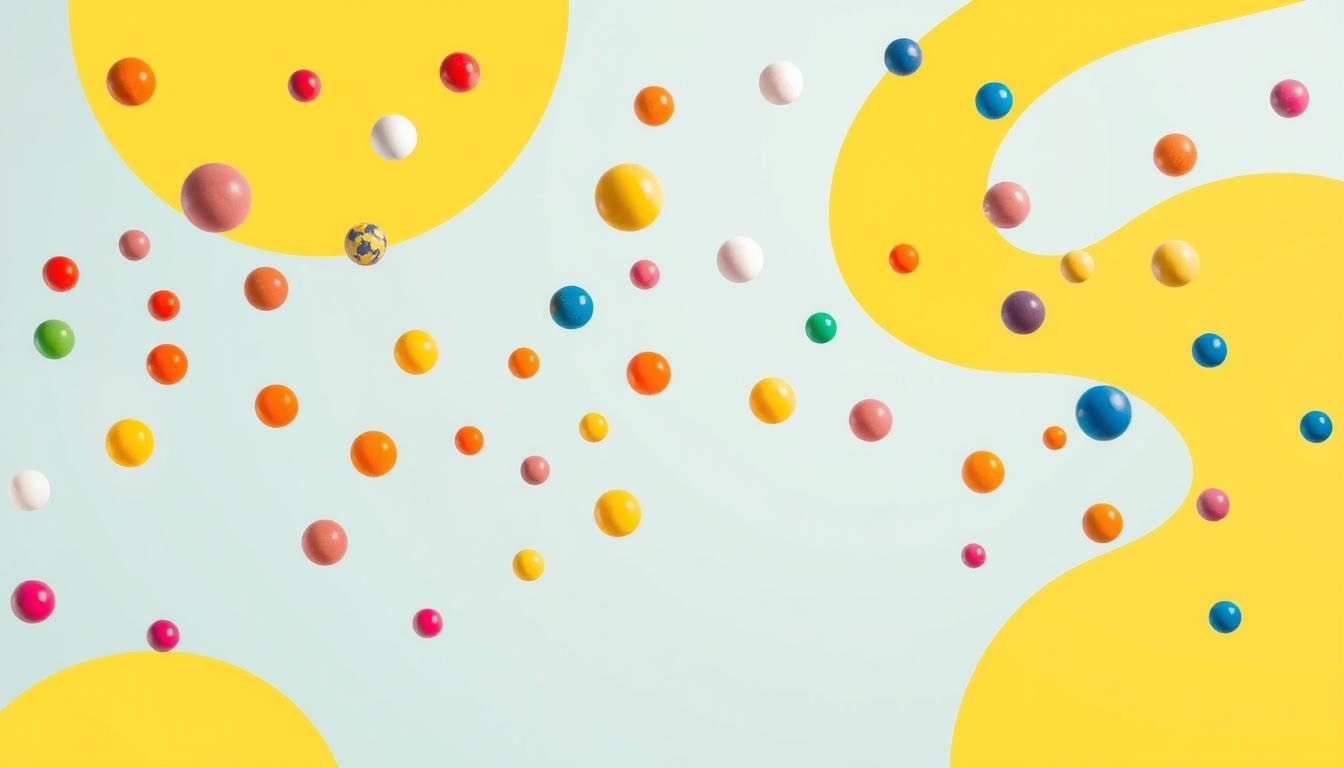A vibrant and dynamic scene showcasing a variety of colourful juggling balls in mid-air, with a serene park setting in the background. Include soft sunlight filtering through green trees and a grassy area where shadows dance, emphasizing movement and joy. The juggling balls should be in different sizes and patterns, capturing the essence of playfulness and fun associated with learning to juggle.
Juggling turns ordinary moments into amazing shows. It’s a fun skill that can impress friends and become a cool hobby.
New jugglers start with curiosity and patience. This guide helps you begin your juggling adventure.
We’ll cover basic moves and cool tricks. These will make you stand out.
Juggling is more than tossing things in the air. It sharpens your focus and hand-eye teamwork.
It’s also a great brain workout. With practice, anyone can learn to juggle.
We’ll break down hard moves into easy steps. You’ll see why juggling is so special.
It tests your mind and body in new ways. Get ready for an exciting juggling journey!
This guide will give you the know-how to start juggling. You’ll feel confident and eager to try.
What is Juggling?
Juggling is an old art of keeping objects moving by throwing and catching. It needs skill, focus, and lots of practice.
Jugglers use balls, clubs, rings, or other items to create amazing shows. They show off their quick hands and great control.
Juggling has been around for thousands of years. Old Egyptian tombs have wall art showing people juggling.
In the Middle Ages, travelling performers and circus acts made juggling popular. Now, it’s a respected skill with many benefits.
Juggling can make your brain work better. It can also improve how your hands and eyes work together.
People who juggle get better reflexes and focus. It’s a fun way to exercise your body and mind.
Today, jugglers range from street artists to pro athletes. Some use it to train for sports.
Anyone can learn to juggle. Start simple and keep practising to get better over time.
Getting Started with Juggling
Juggling basics needs careful prep. Pick the right props to start your journey.
Soft, lightweight balls are best for beginners. Tennis balls or juggling balls are easy to catch.
Choose an open area with high ceilings. Your living room or garage can be perfect.
Start with three identical balls. Practice tossing one ball between your hands.
This builds hand-eye coordination. It’s key for successful juggling.
Wear comfy clothes that let you move. Practice near a soft surface.
Be patient. Most folks take weeks to master three-ball juggling.
Your space should be bright and quiet. Start with short 15-20 minute sessions.
Every pro juggler began just like you. They learned step by step.
Basic Juggling Techniques
Juggling can be fun and easy to learn. The two-ball juggle is a great way to start.
It helps you get better at hand-eye skills. You’ll also build muscle memory for harder tricks.
Hold one ball in each hand to start. Toss the balls in an arc from hand to hand.
Keep the height and rhythm the same. Make smooth moves to track the balls easily.
The three-ball cascade is the next step. It uses three balls in a circular motion.
Start with two balls, then add the third. Keep your throws steady across your body.
Practice is key when learning to juggle. Start slow and focus on being precise.
Don’t rush, as it can lead to drops. Take your time to get smooth moves.
Every pro juggler started just like you. These basics build a strong base for tricks.
Stay focused and have fun while you learn. You’ll get better with time.
Progressing to More Balls
Adding more balls to your juggling routine boosts your skills. It takes practice and patience to master advanced juggling techniques.
Perfect your three-ball technique before moving on. Focus on smooth, consistent throws and catches.
Don’t rush into adding more balls too soon. Build muscle memory first to avoid common mistakes.
Start with a four-ball fountain pattern. Keep your throws steady and maintain a consistent rhythm.
Watch your hand height and ball arcs. Practice slowly and deliberately for the best results.
Common errors include dropping balls and losing rhythm. Practice in front of a mirror to spot mistakes.
Recording yourself can help identify technical issues. Remember, even pros started as beginners.
Try new patterns as your skills improve. Embrace challenges and learn from your failures.
Advanced juggling is an ongoing learning process. Keep pushing yourself to reach new heights.
Juggling Patterns You Should Know
A vibrant scene depicting a variety of juggling patterns in action, showcasing colourful balls and clubs being tossed gracefully through the air, set against a bright, cheerful background with abstract shapes and curves representing movement and rhythm. The focus is on the fluidity and dynamics of juggling, emphasizing different patterns like columns, cascades, and multiplex throws without any characters or text.
Basic juggling is just the start. Learn new patterns to boost your skills.
Fountain juggling throws balls in arcs from both hands. It creates a smooth, pretty look.
Start with two balls in the fountain pattern. Add more as you get better.
Shower juggling is harder. One hand throws while the other catches and passes back.
It makes balls look like they’re “showering” in an arc. This needs good timing.
These patterns help improve hand-eye coordination. They also make you more aware of space.
Start slow and focus on steady throws. Keep a good rhythm as you practice.
Try different patterns to keep juggling fun. Each new pattern helps you grow.
Advanced Juggling Techniques
Advanced juggling techniques are thrilling for skilled jugglers. Two-in-one juggling is a big step up in skill level.
This method involves handling multiple objects at once. It needs sharp hand-eye coordination and muscle control.
Multiplex juggling is a complex method for expert jugglers. It means throwing many balls from one hand at once.
This type of juggling requires intense focus. Jugglers must time multiple throws while keeping rhythm.
Mastering these techniques takes lots of practice. Start by breaking down complex moves into smaller steps.
Visual tracking and muscle memory are key. Practice slowly at first, then speed up as you improve.
Use drills to get better at two-in-one and multiplex juggling. Begin with light objects before using regular juggling balls.
Record your practice to spot areas to improve. This helps track your progress over time.
Advanced juggling opens up new ways to express yourself. With practice, basic skills can become amazing shows.
Juggling and Coordination
Juggling improves coordination and brain function. It creates positive changes in your brain’s neural pathways.
Juggling develops hand-eye coordination. It requires timing, spatial awareness, and complex motor control.
The brain processes multiple moving objects quickly. This creates new neural connections for better cognitive performance.
Studies show juggling increases brain grey matter. It improves reaction times, spatial reasoning, and brain plasticity.
Juggling challenges your brain to do many tasks at once. This can help with multitasking in daily life.
Juggling practice can boost mental agility. It also strengthens cognitive flexibility.
Start with simple juggling patterns. Gradually increase the difficulty as you improve.
New juggling techniques build stronger brain connections. This makes your brain more adaptable and responsive.
Juggling is fun and boosts brain performance. It’s a unique way to enhance cognitive skills.

Incorporating Juggling into Your Lifestyle
Juggling can change your daily routine. It’s a fun way to boost your body and mind.
This skill helps manage stress and improves focus. The rhythm calms your mind while testing your coordination.
Start with 10-15 minutes of juggling each day. Make a cosy spot at home for practice.
Many people use juggling as a great break activity. It boosts brain power and gives a quick workout.
Athletes and office workers love the juggling lifestyle. You only need three balls and some space.
Try it during work breaks or while watching TV. The key is to practice often and have fun.
Keep track of your progress to stay motivated. Begin with simple three-ball tricks.
Slowly add harder moves as you improve. Set small goals and celebrate your wins.
Remember, juggling gets better with time and practice. Enjoy the learning process!
Joining the Juggling Community
Juggling is more than just a solo act. The community offers chances for growth, friendship, and skill-building.
Local clubs welcome jugglers of all levels. They create a space for people to learn and connect.
Online resources have changed how jugglers interact. Websites like JugglingDB and Reddit forums bring jugglers together worldwide.
These platforms help beginners find mentors. Advanced jugglers can share complex tricks here, too.
Finding local clubs is often easy. Check community centres, colleges, and rec spaces for meetups.
Social media and juggling sites list clubs and events. Many cities host regular gatherings for jugglers.
Virtual workshops and YouTube tutorials expand learning options. International conventions connect you with pros and passionate amateurs.
Joining the community turns juggling into a fun, shared experience. It’s a great way to grow your skills.
Tricks to Learn Once You Master Basics
Passionate jugglers explore exciting tricks after mastering the basics. Object juggling becomes an art form with unique items beyond balls.
Skilled jugglers use kitchen utensils and sporting equipment. They find new ways to make their craft better.
Advanced jugglers often try fire juggling. This needs lots of training and safety rules.
Start with practice props before trying dangerous shows. Good hand-eye skills are key for these risky tricks.
Pros suggest trying different objects and rhythms. Complex tricks need precision and lots of practice.
Workshops and experienced jugglers can help you learn advanced skills. They teach special show techniques too.
People love watching jugglers use unusual objects. Skilled artists do hard tricks that amaze crowds.
Some jugglers spin clubs or manipulate rings. Others do complex math-based juggling patterns.
FAQ
How long does it take to learn basic juggling?
Most beginners can learn basic three-ball juggling within 1-2 weeks. Daily practice of 15-30 minutes is key.
Patience and regular practice matter more than natural talent.
What are the best props for a beginner to start juggling?
Soft juggling balls or beanbags are ideal for beginners. They’re light and won’t roll away when dropped.
Tennis balls can work, too, but they’re more slippery.
Is juggling good exercise?
Juggling is a fun full-body workout. It improves hand-eye coordination and builds arm strength.
It also enhances mental focus, engaging both the body and brain.
Do I need a lot of space to practice juggling?
You only need about 6-8 feet of clear vertical space. A living room, garage, or outdoor area works well.
Can children learn to juggle?
Yes! Children as young as 6 or 7 can learn juggling. It helps develop motor skills and concentration.
Many kids find juggling both fun and challenging.
What if I keep dropping the balls?
Dropping balls is normal and part of learning. Even pros drop balls while learning new tricks.
Stay patient and focus on your technique, not perfect performance.
Do I need special juggling balls to get started?
Dedicated juggling balls are ideal, but you can start with household items. Try beanbags, soft tennis balls, or rolled-up socks.
Find objects that are uniform in weight and size.
Is juggling only for performers?
Juggling is for everyone! It’s a great hobby, exercise, and stress relief.
You can enjoy it as a personal skill or for performances.
How can I improve my juggling skills faster?
Practice consistently and focus on basic techniques. Watch tutorials and join online juggling communities.
Break down complex moves into smaller steps to learn faster.
Are there health benefits to learning juggling?
Juggling can improve brain plasticity and enhance cognitive function. It also reduces stress and improves hand-eye coordination.
It’s used in therapy to support neurological development and motor skills.
You may also read:The Secret to Improving Your Vertical Leap


